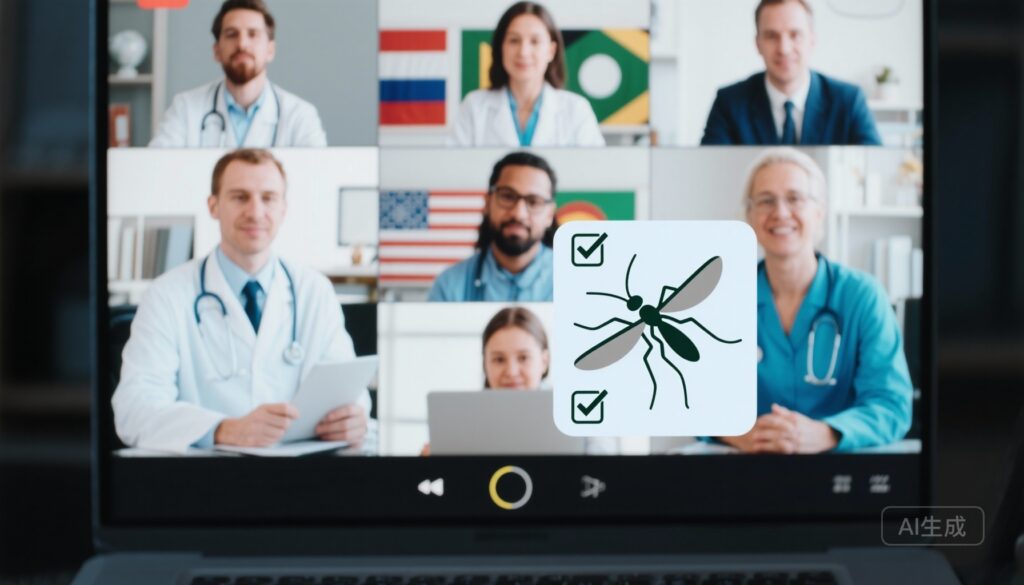Introduction and Context
Dengue is the fastest-spreading mosquito-borne viral disease globally and remains a major public health challenge in tropical and subtropical regions. As dengue incidence rises with urbanisation and climate change, clinical research into therapeutics, diagnostics and supportive care has intensified. However, heterogeneity in which outcomes trials measure and how they measure them makes it difficult to compare studies, combine data in meta-analyses, and translate trial results into clinical and policy decisions.
To address that gap, the DEN-CORE international Delphi consensus project produced a Core Outcome Measurement Set (COMS) for dengue clinical trials. Published in The Lancet Infectious Diseases (Yacoub et al., 2025), DEN-CORE followed accepted core-outcome development standards to define a minimal, harmonised set of outcomes and measurement instruments for use in future dengue trials. This article summarises the consensus process and practical recommendations from DEN-CORE and highlights implications for clinicians, trialists and policymakers.
Key references include the DEN-CORE publication itself and established methodological guidance from the COMET Initiative and WHO dengue guidance for clinical practice and research planning [1–3].
Why the consensus was needed
– Outcome heterogeneity: A systematic review during phase 1 of DEN-CORE documented wide variation in which endpoints dengue trials report (clinical signs, laboratory markers, composite scales, resource use) and how they are defined and measured. This prevents meaningful meta-analysis and obscures clinically relevant effects.
– Patient-centred priorities: People with lived experience of dengue emphasised outcomes often under-represented in trials (e.g., functional recovery, time to return to usual activities).
– Trial efficiency and uptake: Regulators, funders and journal editors increasingly expect standardised outcome reporting. A globally relevant COMS can increase comparability and credibility of evidence.
New guideline highlights (DEN-CORE COMS — headline recommendations)
– Two core sets: DEN-CORE defines a core outcome set for hospitalised dengue and a broadened set for early-stage dengue (outpatient or early admission), reflecting differing trial goals and contexts.
– Outcomes favoured: The hospitalised dengue COMS includes seven outcomes; the early-stage dengue COS adds four more (11 total for early-stage trials). The paper’s full list is reproduced and explained below.
– Measurement instruments: Phase 2 identified acceptable measurement instruments and standardised definitions, and these were finalised in a hybrid international workshop.
– ICU recommendations: For trials conducted in ICU/high-dependency settings, DEN-CORE recommends using existing ICU-specific COS where appropriate, rather than duplicating measures.
– Unified clinician-reported definitions: Nine clinician-reported outcomes were given harmonised definitions to improve inter-trial consistency.
Key takeaways for clinicians and trialists:
– Include the COMS outcomes (at minimum) in dengue trial protocols and publications.
– Use the recommended measurement instruments and timepoints to enable pooling of results.
– For critical care trials, align with ICU outcome standards endorsed by critical care networks.
Updated recommendations and what changed
DEN-CORE is not a disease-management guideline; it is a research standard. Its ‘‘updates’’ relative to prior research practice are procedural and operational:
– From heterogeneous to harmonised: Previous dengue trials reported a wide array of endpoints; DEN-CORE prescribes a minimal unified set (seven to eleven outcomes depending on trial context).
– Emphasis on patient-centred and resource-use outcomes: Beyond virological and laboratory endpoints, the COMS includes functional recovery and healthcare resource utilisation.
– Standardised definitions: Where previously trials used differing definitions for the same concept (e.g., ‘‘severe bleeding’’), DEN-CORE provides unified clinician-reported outcome definitions.
– Integration with ICU COS: Instead of creating bespoke ICU endpoints, DEN-CORE endorses established critical-care outcome measures where trials enroll critically ill patients.
Evidence driving the updates: The DEN-CORE process combined a systematic literature review, qualitative interviews with patients and caregivers, expert panel review, a two-round modified Delphi survey and structured consensus meetings—approaches aligned with COMET and COS-STAD methodological guidance for core outcome development [2].
Topic-by-topic recommendations
Below is a concise summary of the COMS outcomes and measurement recommendations. For full operational definitions and instrument choices, see the DEN-CORE paper [1].
1) Recommended core outcomes for hospitalised dengue trials (minimum set — 7 outcomes)
– All-cause mortality (during hospitalisation and at a defined follow-up timepoint, e.g., 28 days)
– Progression to severe dengue (using harmonised, clinician-reported definition)
– Major bleeding requiring intervention or transfusion
– Shock or need for organ support (vasopressor use, mechanical ventilation, renal replacement therapy)
– Clinically significant plasma leakage leading to hypovolaemia or intervention
– Time to clinical recovery or resolution of key dengue symptoms (fever, abdominal pain, bleeding)
– Healthcare resource use (length of hospital stay, ICU admission)
2) Additional core outcomes for early-stage dengue trials (adds 4 outcomes; total 11)
– Laboratory virological markers (viral load profile or viral clearance time, where feasible)
– Symptom burden and functional recovery (patient-reported outcome measure or standardised diary)
– Need for hospitalisation (for outpatient trials: conversion to inpatient care)
– Return to normal activities or work (time to resume employment/school)
3) Measurement instruments and timing
– Mortality: report in-hospital and at a pre-specified follow-up time (commonly 28 days); specify cause where available.
– Severe dengue: use the DEN-CORE harmonised clinician-reported definition (see below) to classify progression.
– Bleeding: report major bleeding using standard transfusion/ intervention thresholds.
– Organ support: specify criteria for vasopressor initiation, mechanical ventilation, and renal replacement therapy (RRT). Record durations.
– Patient-reported outcomes: use short, validated symptom diaries or simple functional scales adapted to local languages; record baseline and pre-defined follow-up days.
– Resource use: length of stay, ICU days, and re-admissions within 28 days are minimum requirements.
4) Clinician-reported unified definitions
DEN-CORE provides unified operational definitions for nine commonly used clinician-reported outcomes (examples):
– Severe dengue progression: defined by objective criteria (e.g., plasma leakage with shock, significant bleeding with haemodynamic compromise, or organ impairment exceeding pre-specified thresholds).
– Major bleeding: bleeding requiring transfusion, surgical/ endoscopic intervention, or resulting in haemodynamic instability.
– Shock: systolic blood pressure < age-adjusted threshold with requirement for fluid bolus and/or vasopressor to maintain perfusion.
(Full list and wording are in the DEN-CORE publication and should be used verbatim in protocols/publications) [1].
5) ICU/high-dependency unit trials
– For trials primarily enrolling critically ill patients, DEN-CORE recommends adopting existing ICU core outcome sets—especially for long-term functional outcomes and health-related quality of life—rather than substituting dengue-specific endpoints alone.
– Short-term ICU outcomes (organ support-free days, ICU mortality, long-term functional status) should be reported alongside the dengue COMS where feasible.
6) Special populations
– Children: DEN-CORE emphasises age-appropriate measurement instruments and age-stratified reporting (especially for haemodynamic thresholds and functional measures).
– Pregnant people: report pregnancy-specific outcomes and neonatal outcomes as applicable; include both maternal dengue outcomes and obstetric endpoints.
– Resource-limited settings: recommend pragmatic instruments (simple symptom checklists, logbooks for return-to-work) and clear reporting of measurement feasibility and missing data.
Practical checklist for trialists (protocol stage)
– Include all DEN-CORE outcomes that are relevant to your trial population and context (hospitalised vs early-stage).
– Pre-specify primary and secondary outcomes from within (and beyond) the COMS; do not omit COMS outcomes without explicit justification.
– Use DEN-CORE harmonised definitions and recommended instruments; report exactly as specified to facilitate pooling.
– Plan for patient-reported outcome collection and translation/validation where needed.
Expert commentary and areas of debate
DEN-CORE used a broad, international Delphi panel including clinicians, trialists, patients with lived experience, and public-health experts. Several themes emerged in the consensus discussions:
– Value of simplicity vs comprehensiveness: Some experts argued for a minimal set focused on mortality, severe dengue and organ support; others insisted on including functional recovery and resource-use to reflect patient and health-system priorities. The compromise was a compact set for hospital trials and a larger set for early-stage trials.
– Virological endpoints: While virological markers are informative for antiviral trials, resource and laboratory constraints in many endemic settings limit their routine use. DEN-CORE recommends virological measures where feasible, but not as mandatory for all trials.
– ICU outcomes alignment: Critical-care specialists emphasised that dengue critical illness shares outcome domains with other causes of sepsis and organ failure. The recommendation to align with existing ICU COS encourages comparability across critical-care research but requires careful mapping between dengue-specific and ICU outcome definitions.
– Implementation challenges: Panelists noted that uptake depends on funder and journal buy-in, pragmatism in low-resource settings, and availability of validated patient-reported measures in local languages.
Implications for clinical practice and research
– Improved evidence synthesis: Widespread adoption of DEN-CORE will enable more reliable meta-analyses and pooled estimates of treatment effects.
– Better-designed trials: Investigators can prioritise outcomes meaningful to patients and health systems, improving the relevance of trial findings.
– Policy and guideline impact: Regulators and guideline developers will be able to base recommendations on harmonised endpoints, increasing clarity for practice.
– Operational needs: Implementation will require translation of patient-reported tools, training on standardised definitions, and possibly modest additional data collection (e.g., functional status follow-up).
Fictional vignette to illustrate application
Jacob is a 28-year-old teacher in a dengue-endemic city enrolled in a multicentre outpatient trial testing an antiviral agent for early dengue. The trial protocol uses the DEN-CORE early-stage COMS: viral clearance at day 5 (secondary), symptom burden diary through day 14 (primary patient-reported outcome), need for hospitalisation by day 28, and return to normal activities. Using the COMS means Jacob’s outcomes will be directly comparable to other antiviral trials, facilitating pooled analyses that can inform regulatory decisions and clinical guidelines.
Limitations and future directions
– DEN-CORE provides minimum standards; high-quality trials may include additional, hypothesis-driven endpoints. Trials must still ensure rigorous randomisation, blinding and statistical analysis plans.
– Measurement instruments—especially patient-reported tools—need validation in diverse languages and cultural contexts. Work to adapt and validate the recommended instruments is a priority.
– Long-term outcomes: The immediate COMS focuses on short-term clinical and resource metrics; as dengue research matures, consensus on longer-term sequelae (if any) may be needed.
References
1. Yacoub S, Demidova A, Chan XHS, et al.; DEN-CORE Study Group. Core outcome measurement set for clinical trials in dengue: an international Delphi consensus study (DEN-CORE). Lancet Infect Dis. 2025 Oct 7:S1473-3099(25)00500-6. doi: 10.1016/S1473-3099(25)00500-6.
2. COMET Initiative. The COMET Initiative: core outcome measures in effectiveness trials. https://www.comet-initiative.org (accessed Nov 2025).
3. World Health Organization. Dengue: guidelines for diagnosis, treatment, prevention and control. Geneva: WHO, 2009. https://www.who.int/publications/i/item/9789241547871 (accessed Nov 2025).
Note: Readers should consult the full DEN-CORE publication for the verbatim outcome definitions, recommended measurement instruments and operational guidance for inclusion in trial protocols and registries.



